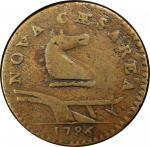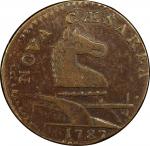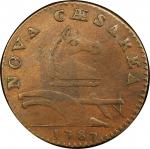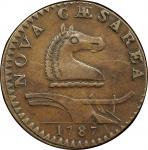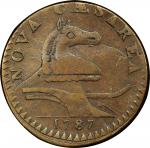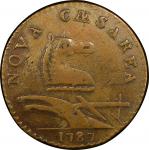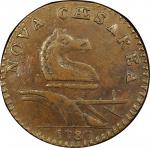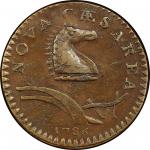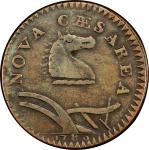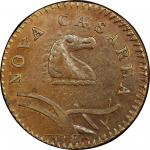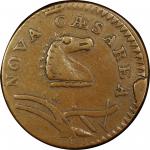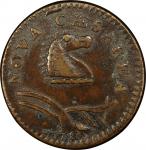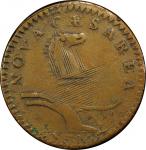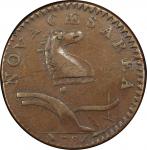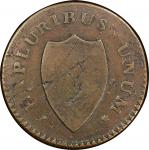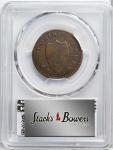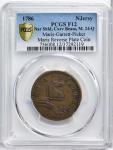1786 New Jersey copper. Maris 24-Q. Rarity-7+. Narrow Shield, Curved Plow Beam. F-12 (PCGS).149.3 grains. In the lower left corner of Dr. Maris enormous and elegant photographic plate there appears a singleton, a reverse die married to just one obverse, illustrated by a distinctively centered and apparently well worn coin. Maris called his 24-Q "exceedingly rare," noting "I have seen but two." In 1886, he called his prize "a very good specimen, and choice of the only two known," deeming it important enough to photographically plate in the sale catalogue of his collection. Alas, T. Harrison Garrett purchased his entire cabinet of New Jersey coppers intact. Most of his coins were sold by Johns Hopkins University in 1980, but Richard Picker was able to acquire some privately as the university upgraded other portions of their collection. This rarity, one of just five specimens known, has not sold at public auction in 133 years.<p><p>This example is ranked third of the four listed in the SHI Condition Census, but is quite similar in quality to the Bareford coin that precedes it. At the time of that coins last auction appearance in 1984, it was called "the rarest coin in the collection." Even with five specimens now recorded - including the newly discovered VF-20 (PCGS) specimen sold for $82,250 in our November 2016 sale - its importance is perhaps even greater today. The surfaces are mostly hard and smooth, evenly toned a deep olive. The visual appeal is excellent for the grade, and the sharpness suggests a higher one considering how featureless the shield details appear on all known specimens. The obverse is centered towards 7:00, with complete denticles seen at top and right. The reverse is neatly aligned to 12:00, with the boldest denticles at the base of that side, as seen on the Maris plate. Some natural striations are seen on the shield, leftover from the planchets creation and left unobliterated after striking. Similar but less noticeable striations are noted on the obverse, one running vertically across the plow handles, another on a diagonal from snout to the denticles above EA of CAESAREA. Two old contact marks are seen beneath AR of that word, and a dusting of dark inactive verdigris is noted across the reverse. The patina is a bit thin at E on the reverse, where some of that verdigris was apparently pushed around. The rims are clean and undamaged, and the details far exceed the VG ranking at which this coin is listed on the census. The details that are present on the shield, limited some horizontal stripes across the top of that feature, are every bit as sharp (sharper?) than the Bareford coin graded F and listed one spot ahead of it. We would not dismiss an argument calling this coin a technical low-end VF.<p><p>The best of the surviving examples of Maris 24-Q is either the Anton Collection coin, a VF- that has never been offered at public auction, or the new piece from our November 2016 sale. The specimen ranked lowest on the census is the Foreman-Henry Garrett coin, carried on the census as a VG but clearly lower quality than this one. It should be noted that the image atop p. 276 that purports to be the reverse of the Foreman-Garrett Maris 24-Q is actually an image of the Foreman 24-I. <p><p>The rarity of this variety has held up well over the decades. The Foreman-Henry Garrett coin, apparently cherrypicked by the inimitable Mike Ringo at the 1987 ANA, was the one to tip this variety from Rarity-8 to Rarity-7+. The population was two in 1881 and is just five today. A bit of a bulge is seen at the lower right of the shield on the reverse, certainly not advanced enough in its present state to condemn the die to instant death, but the rarity of this die - and the fact that it was never married to another obverse - suggests that something cataclysmic happened in short order. None of the survivors have much central detail, suggesting that the swelling may have been worse and more widespread that the evidence of five well worn survivors might indicate.<p><p>Considering that all five survivors are fairly well worn, we suspect that most collectors would rather have Maris plate coin than any other specimen. Unless youre more than 133 years old, this is your first shot to obtain that coin at auction.<p><p>From the E Pluribus Unum Collection of New Jersey Coppers. Earlier, Dr. Edward Maris Collection; H.P. Smith’s sale of the Dr. Edward Maris Collection, June 1886, lot 398; T. Harrison Garrett Collection; Johns Hopkins University to Richard Picker Collection; Stack’s sale of the Richard Picker Collection, October 1984, lot 203; William Anton Collection; E Pluribus Unum Collection, via Larry Stack.


